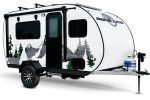Motorbike Tow-Behind Trailers
Guide to Towing
Motorbike tow-behind Trailer - The guide on how to make the motorbike “Journey” not only exciting but also safe.
Countless movies were made about motorbike riders, and many of us still have vivid pictures of large “swarms” of imposing riders on their equally impressive “machines”. But these pictures represent only one-sided stories. It’s because these days, also individual motorbiking became popular as one of the ways to escape daily stress, crowds, and hectic city life by taking on roads less traveled.
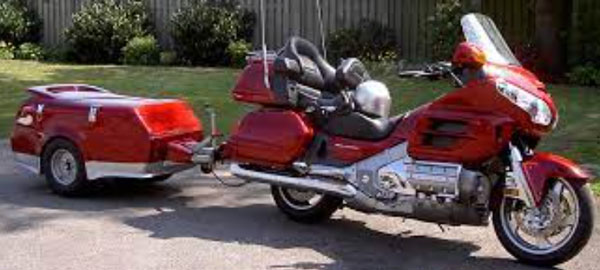
The tandem: Motorbike with a tow-behind trailer (Source: FEMA)
Motorbiking is a way of living, it’s a freedom to hit the road to explore and discover the world. It’s a “journey” that combines the best experiences of backpack hiking, mountain biking, and horse riding. After all, from the motorbike’s saddle, the world seems to be “friendlier” and greener when compared to the one seen from behind a windshield and steering wheel on a highway.
For a long time, motorbikes were considered a means of personal transport from point ”A” to point “B”, then as a way to organize social gatherings with friends for fun. In both cases, what you needed was just an impressive motorbike, a few bucks in your pocket, and time. Nowadays, to fully enjoy longer and closer to nature adventures, you will need to carry with you not only enthusiasm in your heart but also some food and camping gear. And, as motorbikes have very limited built-in storage space, you will need the motorbike tow-behind trailer.
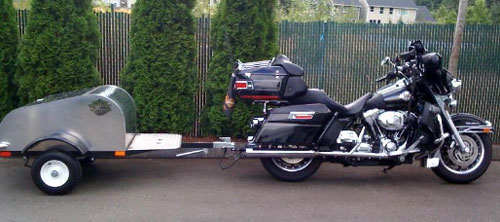
Motorbike Tow-Behind Trailer (Source: Trailers for Less)
Can a Motorbike tow a Trailer?
There is quite an impressive choice of motorbike tow-behind trailers available on the market. But before signing the purchase agreement, you must clearly understand all crucial factors (gov regulations, practical aspects, and safety) that may have an impact on your “motorbike journey”.
It’s not an easy task, and in many situations, you will be making your decisions based on common sense, practice, and advices from experts. The fact is that most manufacturers, to avoid (or minimize) any legal responsibilities related to the warranty, do NOT support towing (some may even openly state that a motorbike cannot be used for towing). As a result, you may not find in owner manuals any information about towing capabilities of their bikes.
However, the truth is that motorbikes can tow, but it will be your “homework” to find the corresponding regulations and towing limits that apply to your bike. You will also have to understand the practical aspects of towing the trailer and coming with it responsibilities.
These tasks require some mathematics and guidelines!
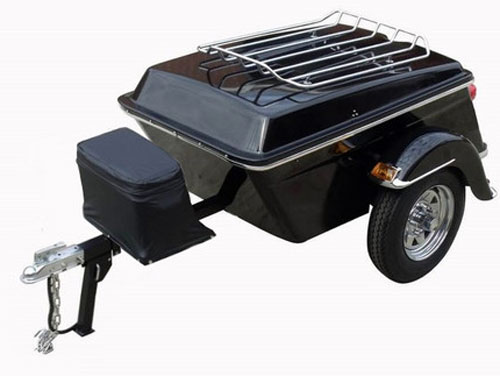
Legend Motorcycle Cargo Trailer
Source: The USA Trailer Store
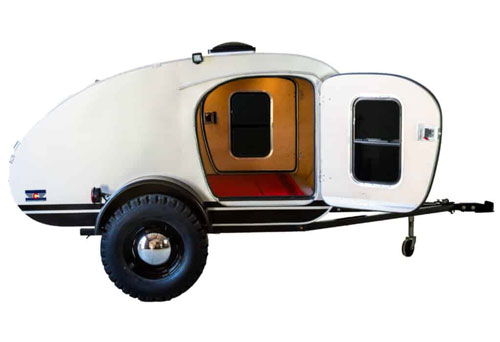
Vintage Overland "Tuco" Motorbike Teardrop
Source: Vintage Overland
Relevant Motorbike's Parameters
Horsepower (hp)
Engine Capacity: The market offers a wide choice of motorbikes with engine capacities ranging from 50cc to more than 2,000cc (where “cc” represents the volume in Cubic Centimeters). Obviously, the higher the engine volume (Capacity), the higher the engine’s Torque and Horsepower (HP). For clarity:
- Torque is the amount of the “twisting” (rotating) force transferred from moving pistons to the engine’s crankshaft. Torque is directly proportional to the capacity of the engine as well as the amount of mixture of air and fuel flowing through the combustion chambers (hence turbochargers can increase the torque of the engine).
- Horsepower expresses the “Peak Power” of mechanical engines (the power of electrical engines is described in Watts). Historically, this definition comes from the time when horses were being replaced by combustion engines, so naturally, their performance was compared to horses. Mathematically, the HP = Max (RPM x Torque) where RPM stands for “Rotations per minute”.
In more practical terms, HP represents a car’s (motorbike’s) ability to accelerate and (in our case) – the power to carry and pull the load (in this case, the trailer).
Although theoretically (and in most countries also legally) each motorbike with a capacity equal to or higher than the 125cc can pull behind the trailer, in practice, for the “Motorbike Journey” you will need at least a motorbike of 1,000cc.
Weight
From the point of view of towing, the two most important motorbike parameters are:
- Curb Weight.
It represents the weight of a “ready-to-go” motorbike. It includes the motorbike itself, engine oil, coolant, brake fluids, and a full tank of fuel (but no optional accessories and gear in storage “pockets”).
- GVWR (Gross Vehicle Weight Rating)
GVWR expresses the maximum weight the motorbike can handle, and it is mostly determined by safety (brakes, suspension, tires ….) and guaranteed road performance (speed, acceleration, braking distance, stability….)
The maximum extra load can be calculated as:
Maximum Extra Load (MEL) = GVWR – Curb Weight – Driver (Passengers) Weight
The mentioned weight specifications are provided by the manufacturer in the owner’s manual. Some manufacturers include them together with the VIN on the metal ID plate attached to the motorbike. When it comes to the Curb Weight, for your security, you can directly measure it on a suitable scale.
Note that the weight of the rider (and passenger - if any) must include their full travel dresses including helmets, and any extra accessories you may have in motorbike storage “pockets”. The resulting number (lbs) represents what is eventually available for the pull-behind trailer.
At first, it seems very optimistic:
The weight imposed by the trailer on the motorbike’s suspension and tires is determined by the trailer’s tongue weight. Typically, for this class of trailers with properly distributed cargo, the tongue weight should not exceed a few tens of lbs. In practice, you will have to take into account the fact that off-road journeys generate a “dynamic” load that will largely exceed the static one expressed by the Tongue Weight.
But that's not all, because regulations also limit the weight of the pulled-behind trailer regardless of how much of the MEL is still available. This weight is determined by:
- Stability of the tandem: Motorbike + trailer
- Motorbike breaks, frame, and “dynamic” stresses
- Overall SAFETY!
A practical approach to motorbike towing
Trailer's Weight and Load Balance
In practice, there is a common understanding that the weight of the loaded trailer must not exceed:
- 20% of the GVWR, or
- 50% of the motorcycle’s Curb Weight + the rider(s)
The maximum permissible weight of the loaded trailer is the lower of two numbers.
However, these are just guidelines. The truth is that a pulled behind trailer drastically changes the “on-road” dynamics of the motorbike. This dynamic as well as overall safety, depends on several factors. One of the most important (on top of your experience and skills) is
Load (Weight) Balance
Understandably, motorbikes are less stable than 4-wheel vehicles. While the total weight of the loaded trailer may be lower than the corresponding limits of your motorbike, a lack of weight balance may seriously impact its stability on the road.
- Too much weight on the rear part of the trailer (behind the axle), will lower the tongue weight but at the same time may “dynamically” pull up the motorcycle’s rear wheel.
- Too much weight in the front of the trailer (before the axle) will increase the tongue weight and add extra stress to the suspension and tires.
The bottom line:
For improved stability, the weight distribution along the trailer must be balanced (evenly distributed) to minimize the effect of swaying (wobbling).
Notes:
- What counts is not only the static load (it’s what you can measure on the scale) but the dynamic one caused by holes and bumps on the road or (in general) driving on uneven paths. These,(depending on the speed) can largely exceed the static loads.
- 2-axle motorbike trailers are safer than single-axle ones, but this safety comes at the price of “extra weight”.
Coupler/Hitch
Forget the traditional “Ball-Coupler-Hitch” used for towing trailers behind cars or trucks. The reason is that they may not provide enough flexibility (movement side-to-side) for motorbike trailers. And it’s not only because when driving on a curve at higher speeds, motorbikes will lean to compensate for “centrifugal” force, while the trailer’s axle will greatly reduce its tilt (It will cause a dangerous “mismatch” between the vertical inclination of the motorbike and trailer, that may not be accommodated by the traditional ball coupler).
There is also another danger when during the towing, for whatever reason, the trailer flips on the side. If the coupling hitch cannot accommodate such rotation, the trailer will also take down the motorbike and its passenger(s).
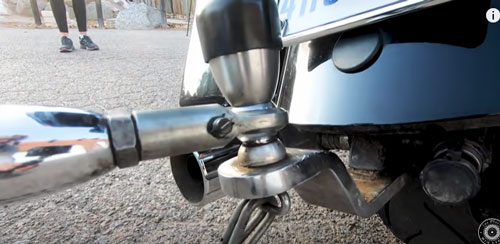
Bushtec Heim Joint Coupler (Source: Bushtec)
That’s why, for improved safety, the motorbike’s coupling mechanism must provide a generous range of rotation. Best models (like Bushtec Heim Joint swivel hitch) offer 360 degrees of rotation. The swivel Heim mounts into the trailer’s tongue, while the “Pin” replaces the traditional “Ball” on the motorbike’s hitch.
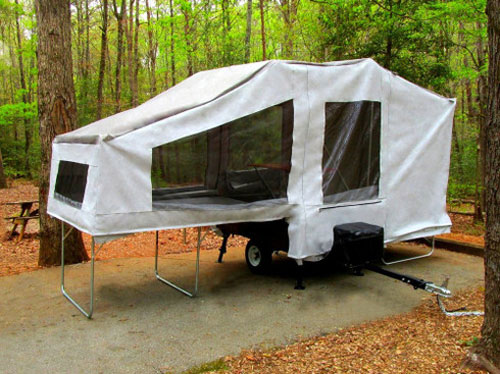
Solace Deluxe Motorbike Camper
Source: The USA Trailer Store
Government Regulations
Trailer Dimensions
The total length of the motorbike and trailer tandem is limited by related regulations. Typically, this limit is specified as the maximum distance between the rear axle of the motorbike and the rear end of the hitched trailer. In most countries, regulations stipulate that it must not exceed 2.5 meters (8.2 ft)
Your responsibilities
Given the fact that at best, motorbikes manufacturers do not take any position on towing, it will be your decision and coming with it responsibility to:
- Find the right parts for towing.
- Use the specialized (knowledgeable) service to attach them to the motorbike’s frame (note that the manufacturer may use this as an opportunity to reject any warranty claims)
Once you successfully accomplish these tasks, make sure that:
- the height of the coupled trailer is correct
- the trailer rear lights are connected to the motorbike signalization system
- the breakaway cable is properly attached
Categories of Motorbike Tow-Behind Trailers
1. Cargo Trailers
They are lightweight, usually Dry Weight (DW) is in the range from 200 -to-400 lbs. They offer precious space for carrying camping gear.
2. Camper Trailers
They are also lightweight (typically, DW < 500 lbs). They combine the functions of a Cargo Trailer with a canvas-based Tent.
3. Teardrop Trailers
They provide “solid” (weather-protected) sleeping space and some storage space. However, with their DW in the range from 500 -to 1,000 lbs, they may be out of the safety zone of popular motorbikes and drivers’ skills.
The following pages are dedicated to presentation of motorbike campers and teardrops:
Go to: --> Motorcycle Campers
Your second block of text...
.


